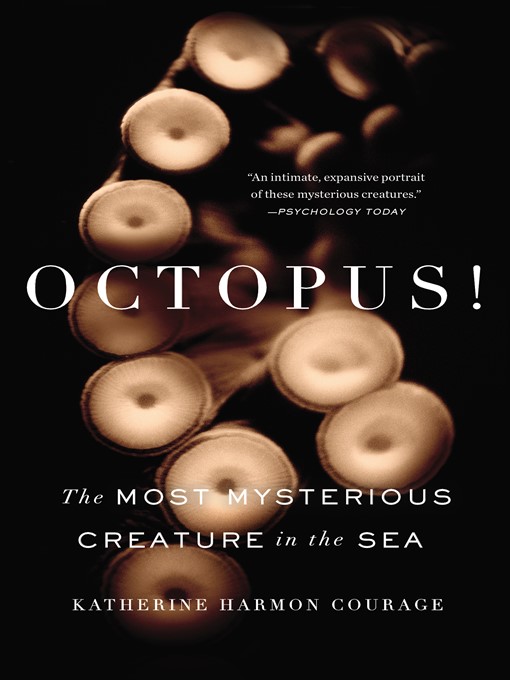
Octopus!
The Most Mysterious Creature in the Sea
کتاب های مرتبط
- اطلاعات
- نقد و بررسی
- دیدگاه کاربران
نقد و بررسی

October 1, 2013
Scientific American associate editor Courage explains why the octopus has been beguiling humans for millennia, making an appearance in "creation myths, art, and, of course, cuisine." A gourmet treat in Mediterranean countries and found in abundance in oceans throughout the world, octopus is a high-protein, low-fat food. A relative of the squid, it is a biological anomaly with three hearts, eight arms and the intelligence to open childproof bottles and solve simple mazes. It is estimated that the octopus has been around nearly 300 million years, predating the dinosaur. Courage chronicles her travels tracking them--e.g., braving rough Spanish seas on a small fishing boat to witness how they are caught and then sampling the local specialty: "a dish of soft-boiled octopus sprinkled with paprika, sea salt, and olive oil." However, the author focuses primarily on their ecological niche. Both predators and prey, octopuses and eels have wrestling bouts to determine who eats whom. As potential prey for barracuda, sharks, sea otters and more, octopuses have developed elaborate defenses. When threatened, they shoot out an irritating burst of black, inky liquid that acts as a shield. Octopuses ordinarily mate only once, in the first two years of their lives, and then die within months. Each female hatches thousands of eggs, most of which perish. Those that survive live solitary lives until they mate. The octopus is thought to be color blind in the ordinary sense of the word, but it has an amazing ability to rapidly camouflage its skin," allowing it to blend seamlessly into the background in color, brightness, and even texture and movement...in about three-tenths of a second." Their skin appears to be capable of perception, directly detecting and responding to the color and polarization of light. A pleasant, chatty book on a fascinating subject.
COPYRIGHT(2013) Kirkus Reviews, ALL RIGHTS RESERVED.

August 1, 2013
Courage (contributing editor, Scientific American) conveys the many attractions and fascinating features of the octopus as she investigates its anatomy, physiology, reproduction, food hunting, and life cycle. Related to squids, cuttlefish, snails, slugs, and oysters, octopuses live all over the world, in shallow water as well as on the ocean bottom, but their elusive nature makes them almost impossible to study in the wild. Widely valued as food, they are also the subjects of scientific research related to aspects of their octopphysiology, such as their camouflage abilities. Their eight independently controlled arms are being studied by biorobotics researchers. Courage travelled widely to interview fishers and scientists in U.S. and European research laboratories to produce this well-written, accessible book. She shows her wonder at the intelligence, playfulness, and curiosity demonstrated by these invertebrates. Courage notes that lab scientists acknowledge the unique personalities of octopuses by giving them each a personal name and that the UK and European Union both have directives to protect octopuses from scientific experiments that may cause pain or suffering. VERDICT While Jennifer A. Mather and others' Octopus: The Ocean's Intelligent Invertebrate is a more comprehensive treatment of the subject, this book will whet the interest of students and the general reader. Recommended.--Judith B. Barnett, Univ. of Rhode Island Lib., Kingston
Copyright 2013 Library Journal, LLC Used with permission.

October 15, 2013
Octopuses have been around for 300 million years, surfacing in ancient mythology and various cuisines and currently living the world over in an array of several hundred species that are, to our mammalian eyes, strange, even alien. Courage, an associate editor of Scientific American, gamely explores the bustling realm of the octopus. She endures seasickness off the coast of Spain while watching two fishermen haul up hundreds of octopuses, adding to the 50,000 tons caught and consumed each year. She follows the tentacle trail to Brooklyn, Puerto Rico, and Greece. But the most fascinating chapters in this entertaining and eye-opening inquiry are Courage's laboratory visits with scientists who are in awe of the smartest invertebrate on the planet. With their three hearts, regenerating arms, remarkable musculature, and superhero powers, octopuses can radically change shape, size, texture, and color. Underwater genies of disguise, they are well-armed and adept at escape. Scientists are eager to learn how these startlingly intelligent and dexterous marine creatures perform their miraculous transformations, and readers will look forward to more of Courage's jauntily elucidating dispatches.(Reprinted with permission of Booklist, copyright 2013, American Library Association.)

























دیدگاه کاربران